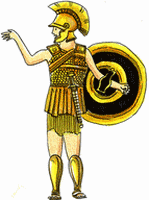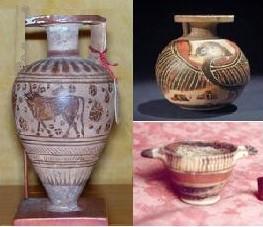Maps of the Antique
Mediterranean Sea
 Greece Greece
 Attic Attic
 Corinth Corinth
 Some dates Some dates
 Archaeological sites Archaeological sites
 Pottery and ceramics Pottery and ceramics
 Magna Graecia Magna Graecia
 Apulia Apulia
 Daunia Daunia
 Gnathia Gnathia
 Campania Campania

|
CORINTHIAN CERAMICS

|
The painted ceramics known as Corinthian comprise two families of shapes which evolved in the same time.
Firstly, a rich series of small vases with black figures - intended to contain oils or perfumes which made the fame of Corinth, such as the aryballoi, alabastres, lekythoi -, decorated with animals (fantastic or real), accompanied by many filling patterns, in particular flowers and rosettes. Secondly, larger pieces intended to provide for the daily life needs - such as olpes, craters or exaleiptrons. Corinthian ceramics is characterized by a light-yellow clay and a painted decoration applying the technique of the black figure, with final improvements carved with a stylus. The figurative patterns are also surrounded by colored spots.
|
During the 6th century B.C. these ceramics are exported all around the Mediterranean sea, not only to the properly Greek cities, but also in places reached by the hellenic influence. They will be largely imitated in Etruria.
In spite of their success, they decline after 550 B.C. when the Athenian ceramic ware become famous and, by the quality of its products, first in black figures and later with red figures, will dominate up to the end of the 4th century B.C.
|
|

















